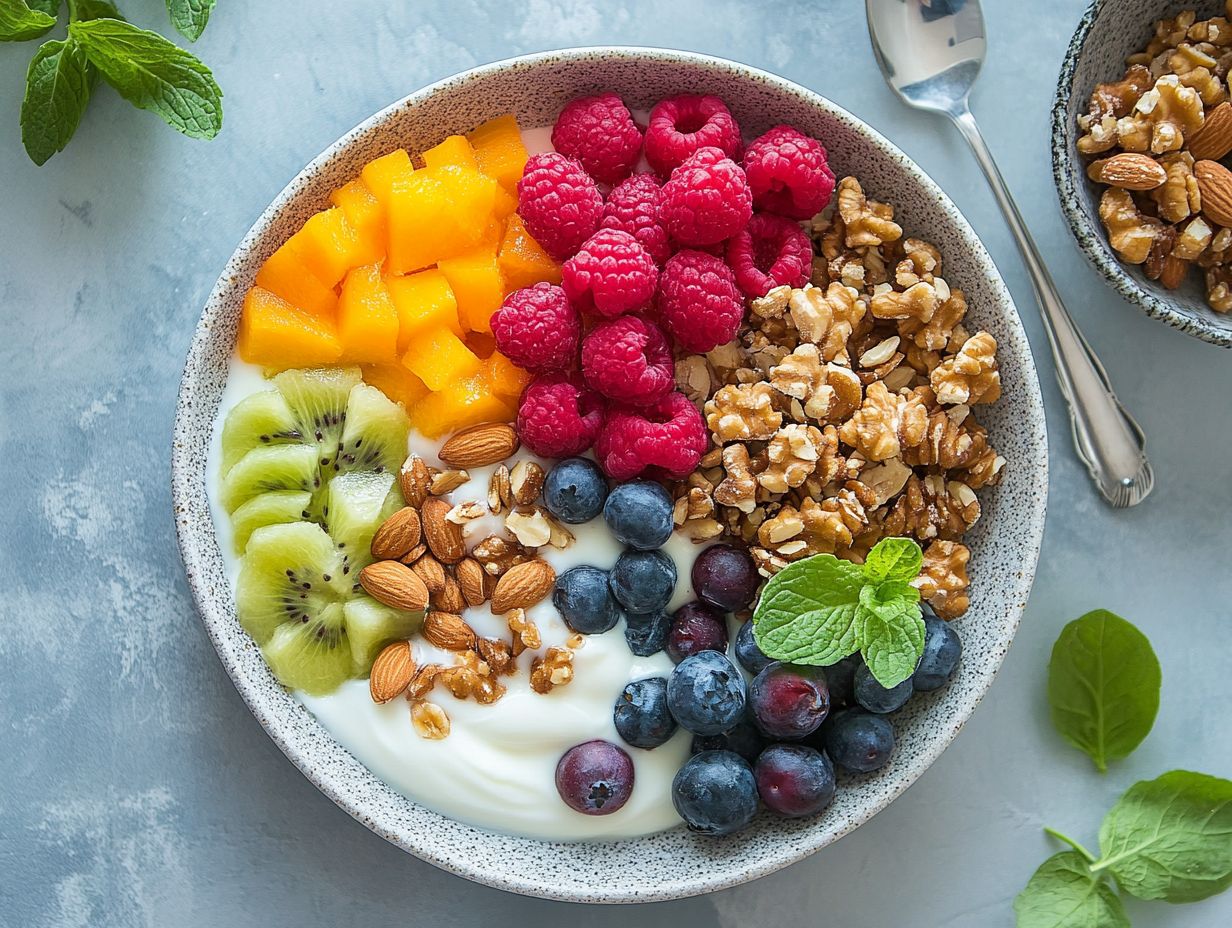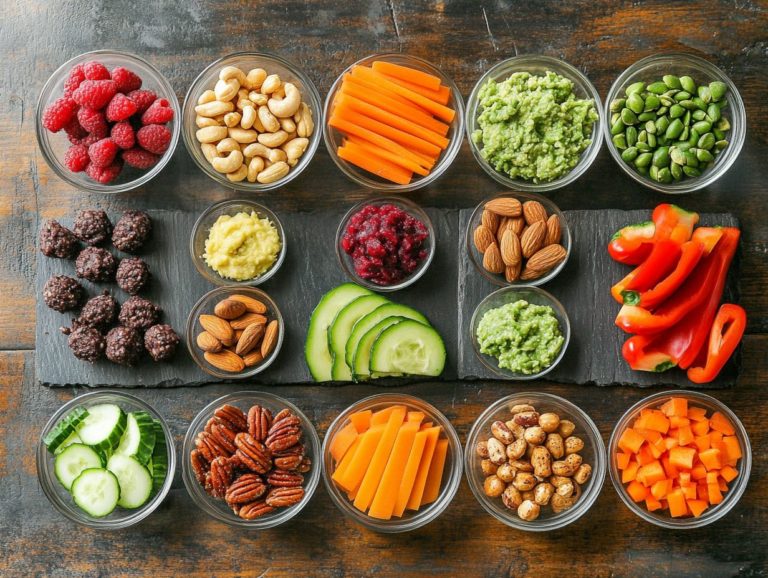Understanding the Importance of a Low-Fat Diet
In a world full of dietary choices, you may find that a low-fat diet is a popular choice for enhancing your health.
But what does a low-fat diet really entail? How can it work to your advantage? Understanding different types of fats and their roles within your body is crucial, along with recognizing the benefits of cutting back on unhealthy fat intake.
Let s explore practical tips to help you succeed. We will address common challenges and highlight the importance of exercise in achieving your desired results.
Get ready to discover how a low-fat diet can truly transform your health and lifestyle.
Contents
Key Takeaways:

A low-fat diet can be defined as one that limits the intake of unhealthy fats, such as those found in fried foods and processed snacks, which offers many benefits for health and wellness.
Fat plays a crucial role in the body, but it’s important to understand the differences between types of fat and limit the intake of unhealthy fats.
Incorporating a low-fat diet can not only improve overall health and prevent diseases but also requires strategies to overcome potential challenges while incorporating exercise for optimal results.
What is a Low-Fat Diet?
A low-fat diet encourages you to limit your intake of dietary fats, especially unhealthy fats, while highlighting the importance of healthier fats.
This strategy promotes heart health and enhances your overall well-being, as endorsed by health experts and organizations such as the American Heart Association and the U.S. Department of Agriculture in their 2020-2025 Dietary Guidelines.
Adopting this diet helps you make better food choices and improve your weight management strategies while focusing on nutrient-rich foods that nourish your body.
Defining Low-Fat and Its Benefits
To define a low-fat diet, you need to grasp its fundamental principles. These include minimizing saturated fats, avoiding trans fats, and prioritizing heart-healthy fats.
This approach not only enhances your overall health but also reduces the risk of cardiovascular disease.
By embracing these principles, you can unlock significant benefits, including improved heart health and lower cholesterol levels.
A well-structured low-fat diet serves as a powerful ally in weight loss and plays a pivotal role in disease prevention, particularly for conditions like diabetes and hypertension.
It s crucial to adopt a balanced approach to ensure that you don t overlook key nutrients. This means incorporating a diverse array of fruits, vegetables, whole grains, and lean proteins into your meals.
Such choices promote a healthier lifestyle and help mitigate the risks associated with nutrient deficiencies.
The Role of Fat in the Body
Understanding the role of fat in your body is essential, as dietary fat performs several vital functions. It provides energy, aids in the absorption of fat-soluble vitamins, and supports cell structure.
However, recognizing that the type and quantity of fat you consume can profoundly impact your health outcomes is important.
Understanding Different Types of Fat
Understanding the different types of fat is essential for making informed dietary choices. These fats can be broadly categorized into saturated fats, unsaturated fats, and trans fats, each carrying unique health implications.
The effects of these fats on your overall well-being can vary considerably.
Unsaturated fats particularly omega-3 and omega-6 fatty acids are vital components of a balanced diet. You ll find these beneficial fats in sources like fish, nuts, and avocados, where they play crucial roles in promoting heart health and regulating inflammation.
On the flip side, trans fats, often lurking in processed snacks and fried foods, can raise bad cholesterol levels and increase the risk of cardiovascular diseases. Recognizing the sources and effects of these fats is crucial for optimal health management.
This knowledge helps you make choices that improve your health and longevity.
Benefits of a Low-Fat Diet

The benefits of a low-fat diet are numerous, especially when it comes to enhancing your overall health, facilitating weight loss, and lowering the risk of chronic conditions like cardiovascular disease.
This approach aligns seamlessly with dietary recommendations put forth by health experts today.
Start your low-fat journey today and take the first step toward better health!
Improving Overall Health and Preventing Diseases
Improving your overall health and preventing diseases is key to a low-fat diet. This approach lowers the risk of heart problems while providing essential nutrients.
Prioritize whole grains, fruits, and vegetables to manage your weight and enhance your heart health. As you incorporate lean proteins and cut back on fats found in foods like red meat and full-fat dairy that can raise cholesterol levels, you re likely to see improvement in your cholesterol levels, which is vital for preventing various health complications.
This balanced intake of nutrients not only fortifies your immune system but also sustains your energy levels throughout the day. Ultimately, embracing a low-fat diet can become a cornerstone of your healthy lifestyle, enabling you to make informed food choices that promote both your physical and mental well-being.
How to Follow a Low-Fat Diet
Adopting a low-fat diet successfully demands a keen awareness of suitable low-fat options, careful meal planning, and a thorough comprehension of nutrition labels.
This knowledge enables you to make healthy food choices tailored to your unique dietary preferences.
Tips and Strategies for Success
Success in following a low-fat diet truly depends on effective strategies such as incorporating a variety of foods, employing healthy cooking techniques, and preparing meals that embrace low-fat ingredients.
Discover delicious low-fat meals that will excite your taste buds! By exploring fresh produce, lean proteins, and whole grains, you can create meals that delight your palate while aligning seamlessly with your dietary goals.
Experimenting with different cooking methods like steaming, grilling, or baking can significantly reduce unnecessary fats while enhancing the flavors of your dishes.
For instance, using herbs and spices to season your meals adds depth without piling on calories.
Introducing diverse foods like quinoa, chickpeas, and a vibrant array of vegetables can keep your meals exciting and prevent the monotony that often derails dietary plans.
Preparing batch-cooked soups or stir-fries can simplify your mealtime routine while ensuring you stay on track nutritionally.
Potential Challenges and Solutions
Navigating the potential challenges of a low-fat diet, such as managing cravings and maintaining commitment, can be seamlessly addressed with thoughtful strategies.
By incorporating low-fat sweets and embracing healthy fats, you can create a balanced approach that satisfies your taste buds while supporting your dietary goals.
Dealing with Cravings and Sticking to the Diet

Effectively managing cravings is crucial for adhering to a low-fat diet, and employing strategies such as incorporating healthy snacks and careful meal planning can significantly support your dietary goals.
By selecting snacks that are low in fat yet rich in nutrients, you can satisfy your hunger without compromising your efforts. Gaining an understanding of the triggers behind emotional eating enables you to make healthier choices, especially during challenging moments.
Practicing mindfulness enhances your awareness of cravings, promoting a more balanced approach to your eating habits. A well-structured meal plan serves as a roadmap to healthier eating, helping you avoid impulsive decisions.
To boost your motivation, consider setting small, achievable goals and celebrating your progress along the way. This approach can transform your journey into a more enjoyable and rewarding experience.
Incorporating Exercise for Optimal Results
Exercise is essential for your low-fat lifestyle. It boosts your health and helps with weight management. Incorporating movement into your routine sets the stage for lasting results and a healthier you.
The Importance of Physical Activity in a Low-Fat Lifestyle
The role of physical activity in a low-fat lifestyle is paramount. Regular exercise not only boosts heart health but also plays a critical role in weight management and overall wellness.
Incorporating a variety of exercises such as aerobic workouts, strength training, and flexibility routines can help you establish a comprehensive fitness regimen that supports these vital health benefits. Aerobic activities like running or swimming boost your heart health and aid in burning calories. Strength training is essential for building muscle mass, which enhances your metabolic rate.
Don’t overlook practices like yoga or Pilates; they foster flexibility and contribute to mental well-being. When you combine these routines with a balanced low-fat diet, you significantly increase your chances of achieving and maintaining long-term health goals. This holistic approach nurtures both the body and mind, laying the groundwork for a vibrant, fulfilling lifestyle.
Frequently Asked Questions
What is a low-fat diet and why is it important?
A low-fat diet is an eating plan that limits the intake of high-fat foods, such as fried foods, fatty meats, and full-fat dairy products. It is important because consuming too much fat can lead to weight gain and increase the risk of various health conditions, such as heart disease, diabetes, and certain types of cancer.
What are the benefits of following a low-fat diet?

- Weight loss
- Reduced risk of chronic diseases
- Improved heart health
- Increased energy levels
- Lower cholesterol levels
These benefits contribute to overall health and well-being, making you feel even better!
What types of foods should I include in a low-fat diet?
A low-fat diet should consist mostly of plant-based foods, such as fruits, vegetables, whole grains, and legumes. It should also include lean protein sources like fish, chicken, and beans, as well as low-fat dairy products such as skim milk and low-fat yogurt.
Are all fats bad for our health?
No, not all fats are bad for our health. Healthy fats, such as monounsaturated and polyunsaturated fats, are essential for our body and can be found in foods like avocados, nuts, and olive oil. It’s important to limit saturated and trans fats, which can be harmful.
Are there any potential risks of a low-fat diet?
While a low-fat diet can have many health benefits, ensure that you are still getting enough essential nutrients, such as vitamins and minerals. Incorporate a variety of healthy foods and consult with a healthcare professional if you have any concerns.
Can a low-fat diet be sustainable in the long-term?
Yes, a low-fat diet can be sustainable over the long term with proper planning and preparation. Make gradual changes and find a balance that works for your individual needs and preferences. Including a variety of healthy and tasty low-fat meals can make this lifestyle change more enjoyable and sustainable.
Ready to transform your health? Start incorporating more low-fat meals into your daily routine today!






